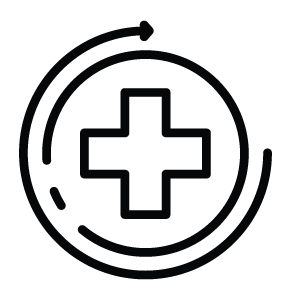Primary Stroke Center
Stroke symptoms, such as numbness on one side of your body, can happen suddenly and without warning, but there is hope. At St. Francis Medical Center, we offer one of the few dedicated stroke programs serving southeast Los Angeles. Our team of experts delivers life-saving care that increases your chances for a good outcome.
For further information, contact us at 310-900-8900
Highlights of Our Program
Recognition: Our commitment to delivering the best available stroke care has been recognized by The Joint Commission with its prestigious advanced primary stroke center designation. This designation is your assurance that we follow care practices that lead to better, safer and more effective care. In fact, the American Heart Association and American Stroke Association have also recognized St. Francis with its Get With the Guidelines Stroke Gold Plus Achievement Award for our commitment to consistently delivering a high level of care.
24/7 Access to Experts: Our team includes brain experts (neurologists) who specialize in stroke care along with specially trained nurses, radiologists, vascular surgeons, rehabilitation therapists and nutritionists. We stand ready to help you any time of the day or night.
Comprehensive Approach: Throughout your care journey, we help you get the best possible care. Our imaging technologies deliver crisp, clear images in seconds to ensure an accurate diagnosis. After treatment, you recover in our intensive care unit (ICU) where dedicated critical care physicians help you recover and protect you from complications. We have a designated Stroke Unit, staffed with nurses trained and educated on the care of stroke patients. Our team of rehabilitation therapists helps you safely transition back to everyday activities.
Care Close to Home: St. Francis has received approved stroke center (ASC) designation from the Los Angeles County Emergency Medical Services Agency (EMS). This designation means that EMS units will transport you by ambulance directly to St. Francis if we are the closest ASC.
Focus on Prevention: After you recover, we deliver personalized treatments and recommendations to help protect you from future strokes. You may receive special medications, education, and support toward making important lifestyle changes, such as learning how to eat a healthy diet.
What is Stroke?
Your brain relies on a steady flow of blood, bringing it the oxygen and nutrients it needs to survive. A stroke happens when a blood clot blocks one of your arteries or an artery ruptures, preventing blood flow to that area of the brain.
Recognizing the signs and symptoms of stroke can help you get care as quickly as possible and reduce your risk for long-term complications. Learn more about the signs, symptoms, and risk factors of stroke.
Meet Our Primary Stroke Team
Our Multi-Specialty Team Includes:
- Stroke Coordinator
- Neurologists and Neurosurgeons
- Nurses
- Radiologists
- Vascular Surgeons
- Nutritionists
- Pharmacists
- Rehabilitation Therapists
- Support Specialists, including Case Managers and Social Workers.
Symptoms
Symptoms of a stroke vary depending on the type of stroke, as well as the location and degree of brain damage. If a stroke is caused by a large blood clot or bleeding, symptoms occur within seconds. When an artery is already narrowed or blocked, stroke symptoms usually develop gradually within minutes to hours or, rarely, days. However, symptoms of a small stroke may be confused with the effects of aging or with conditions that cause similar symptoms.
The effects of a stroke range from mild to severe and may be temporary or permanent. A stroke can affect vision, speech, behavior, the ability to think and the ability to move parts of the body. Sometimes it can cause a coma or death. Just as with a heart attack, someone having a stroke needs immediate emergency care. The sooner medical treatment begins, the fewer brain cells may be damaged. If you see someone exhibiting symptoms of a stroke, call 911 immediately!
Symptoms of a Stroke Include Sudden Onset of:
- Numbness, weakness, or inability to move (paralysis) of the face, arm, leg, especially on one side of the body
- Trouble seeing in one or both eyes, such as dimness, blurring, double vision or loss of vision
- Confusion or trouble speaking
- Trouble walking, dizziness, or loss of balance or coordination
- Severe headache with no known cause
One or more mini-strokes (transient ischemic attacks or TIAs) may occur before a person has a full-blown stroke. Symptoms for both are similar. However, unlike stroke symptoms, TIA symptoms disappear within minutes (usually 10 to 20) up to one hour. A TIA is a warning signal that a stroke may soon occur, and the condition needs to be treated as an emergency.
There Are Two Major Types of Strokes:
- Ischemic Stroke is caused by a blocked or narrowed artery.
- Hemorrhagic Stroke is caused by sudden bleeding from an artery.
Causes
Ischemic Stroke
Ischemic Stoke occurs when blood flow through an artery that supplies blood to the brain is blocked. Blockage may develop from a blood clot in an artery leading to the brain (thrombus) or one formed in another part of the body, usually the heart (embolus). The clot travels with the blood until it blocks an artery in the brain. These blood clots usually are the result of an irregular heartbeat (atrial fibrillation), heart valve problems, infection of the heart muscle, hardening of the arteries, blood-clotting disorders, and inflammation of the blood vessels or heart attack.
A less common cause of ischemic stroke occurs when blood pressure becomes too low (hypotension), reducing blood flow to the brain. This usually occurs with narrowed or diseased arteries. Low blood pressure can result from a heart attack, large loss of blood or severe infection.
Hemorrhagic Stroke
Hemorrhagic Stroke is caused by sudden bleeding from a blood vessel inside the brain (cerebral hemorrhage) or in the spaces around the brain (subarachnoid hemorrhage). Sudden bleeding may result from the bursting of a blood vessel that has stretched and thinned (aneurysm). The most common cause of bleeding inside the brain is high blood pressure.
Uncommon causes of hemorrhagic stroke include inflamed blood vessels, which may develop from syphilis or tuberculosis, blood-clotting disorders, head or neck injuries, radiation treatment for cancer or cerebral amyloid angiopathy (a condition in which a protein substance builds up and weakens the blood vessels in the brain, causing bleeding and a stroke).
Risk Factors
The American Stroke Association has identified several factors that increase your risk of stroke. The more risk factors you have, the greater your chances for a stroke. These factors fall into two categories: those that cannot be modified and those that you can modify through lifestyle changes. Your healthcare provider can help you assess your risk for stroke and recommend ways to control your risk factors and reduce your risk of having a stroke.
Factors That Cannot Be Modified Include:
- Age – The older you are, the greater your risk of having stroke.
- Gender – More men than women have strokes, but more women die from strokes.
- Race – African Americans have a much higher risk of death from a stroke than Caucasians.
- Family History – Your stroke risk is greater if a parent, grandparent, sister, or brother has had a stroke.
- History of Strokes or Heart Attacks – Someone who has had a stroke or a heart attack is at much higher risk of having another stroke.
Risk Factors That You Can Modify Include:
High Blood Pressure – The most important risk factor for stroke.
Diabetes Mellitus – If you have diabetes, work closely with your doctor to manage it.
Carotid or Other Artery Disease – People with peripheral artery disease have a higher risk of carotid artery disease, which raises their risk of stroke.
Atrial Fibrillation – This heart rhythm disorder causes the heart’s upper chambers to quiver instead of beating effectively, which lets the blood pool and clot.
Other Heart Diseases – People with coronary heart disease or heart failure have more than twice the risk of stroke as those with hearts that work normally.
Transient Ischemic Attacks (TIAs) – TIAs are mini-strokes that produce stroke-like symptoms but no lasting damage. Recognizing and treating TIAs can reduce your risk of a major stroke.
Blood Disorders – A high red blood cell count thickens the blood and makes clots more likely. Sickle-shaped red blood cells, in patients with sickle-cell anemia, tend to stick to the blood vessel walls, which in turn can block arteries to the brain and cause a stroke.
High Blood Cholesterol – A major risk factor for heart disease, high blood pressure raises your risk of stroke.
Lifestyle Changes That Can Reduce Your Risk of Stroke Include:
- Stop Smoking – Cigarette smoking is the top preventable risk factor for stroke.
- Maintain a proper weight and exercise regularly.
- Drink Moderately – An average of more than one alcoholic drink a day for women and more than two drinks a day for men raises blood pressure and can lead to stroke.
- Stop using illegal drugs.
Diagnosis
Strokes are diagnosed based on the patient’s medical history and a physical exam. A variety of diagnostic tests are available through the Primary Stroke Center at St. Francis Medical Center. If stroke is suspected, the doctor will order a stat computed tomography (CT) scan to determine whether the stroke was caused by a clot or from bleeding inside the brain. Additional tests may be done depending on the scan results and how soon you arrive in the emergency room. Remember the signs and symptoms of stroke. The earlier you arrive, the more treatment options available to you. If someone is showing symptoms of a stroke, call 911 immediately.
Tests
If the doctor suspects that one of the large arteries in the neck (carotid arteries) is narrowed, the following tests may be done:
- Ultrasound of the carotid artery
- CT Scan to determine if the stroke is ischemic or hemorrhagic
- Magnetic Resonance Angiography (MRA) scan to show the flow of blood through the blood vessels
- Carotid arteriography to show specific arteries
- Transcranial doppler imaging to evaluate blood flow velocities in the brain
- If the doctor suspects the clot started in the heart, a chest X-ray, electrocardiogram (EKG or ECG) or echocardiograph
Treatment
People who have symptoms of a stroke need to seek emergency medical care by calling 911. Prompt medical attention may prevent life-threatening complications and more widespread brain damage and is critical for the best recovery. If emergency treatment is sought within the first one to two hours after symptoms begin, some people with a stroke caused by a blood clot may be able to receive a medication to dissolve the clot (Alteplase).
Treatment may include medication and is based on the type of stroke and the seriousness of the symptoms. The goals of treatment are to prevent life-threatening complications that may occur soon after stroke symptoms develop, prevent future strokes, reduce disability, and help prevent long-term complications.
Featured Services

Emergency and Trauma

Heart Care

Orthopedics and Joint Care

Maternity Care
Behavioral Health



